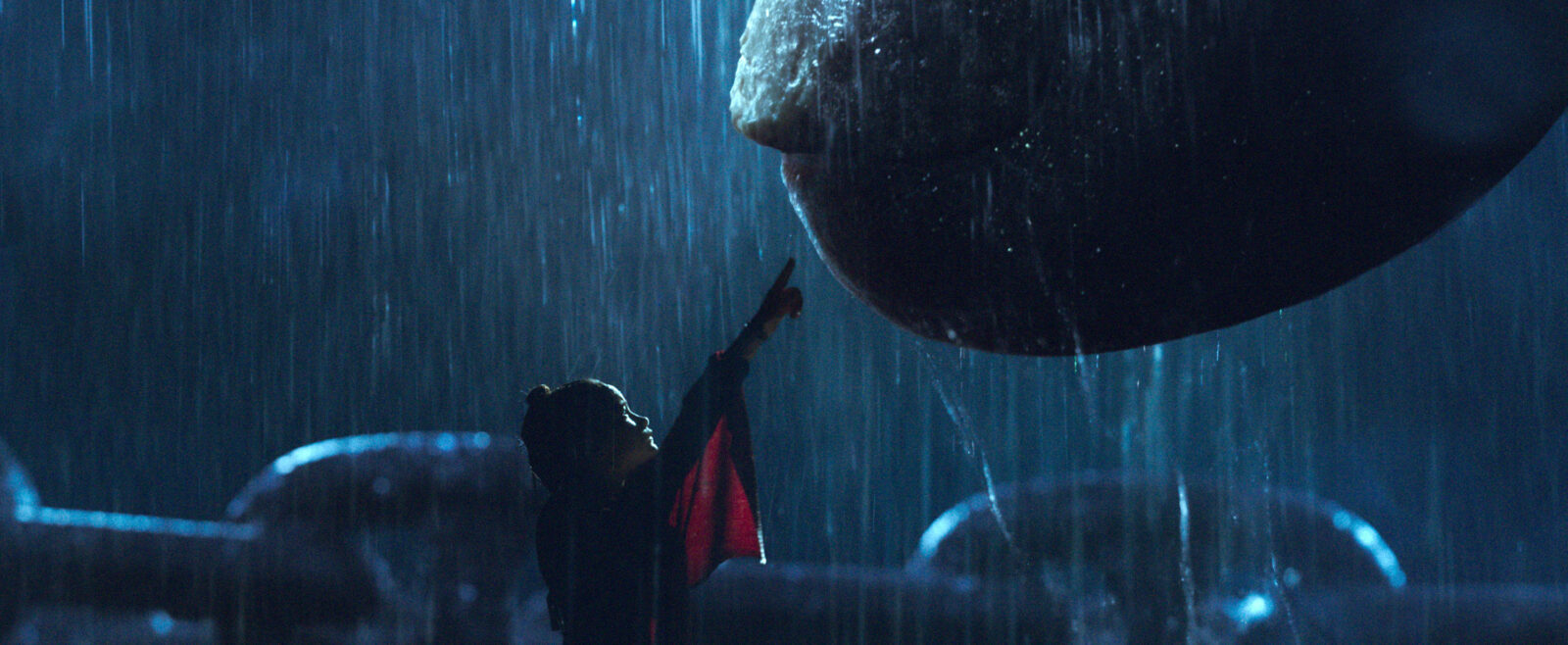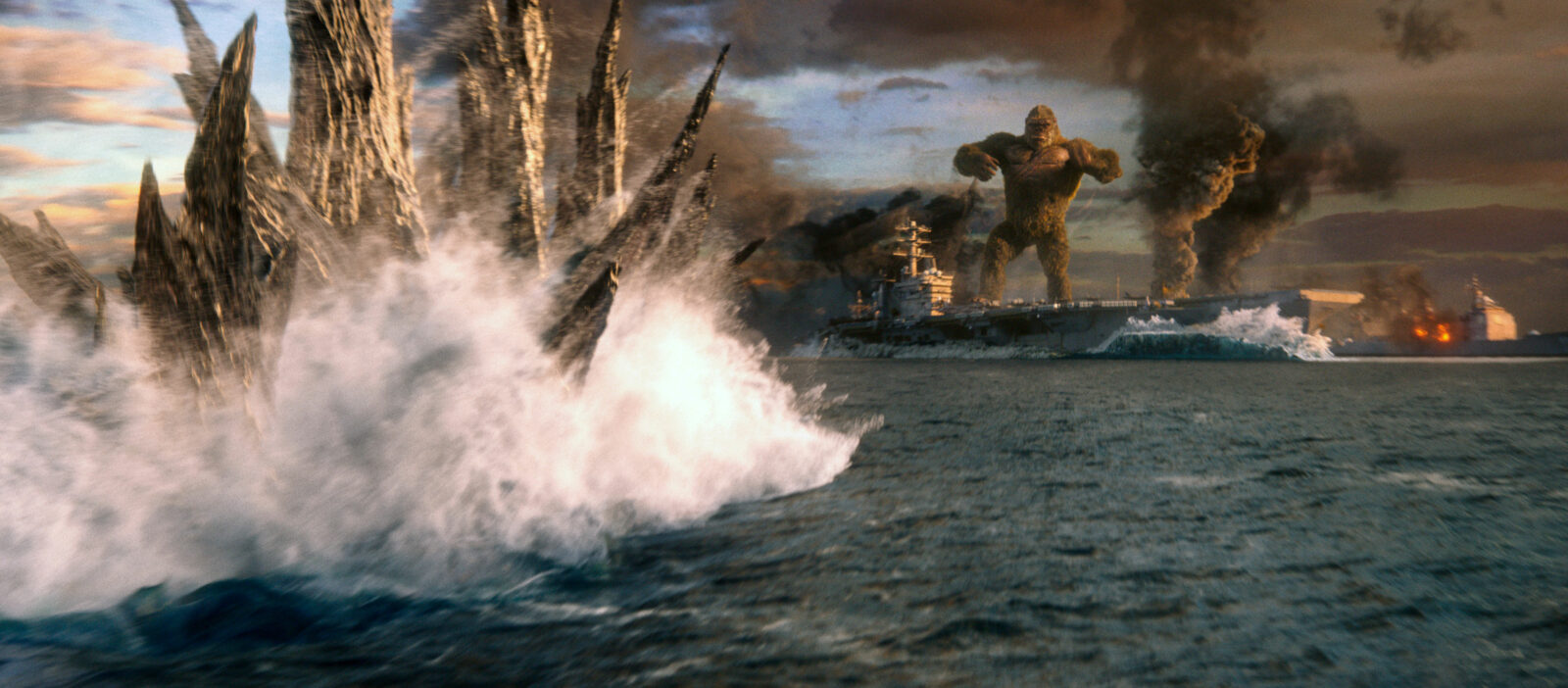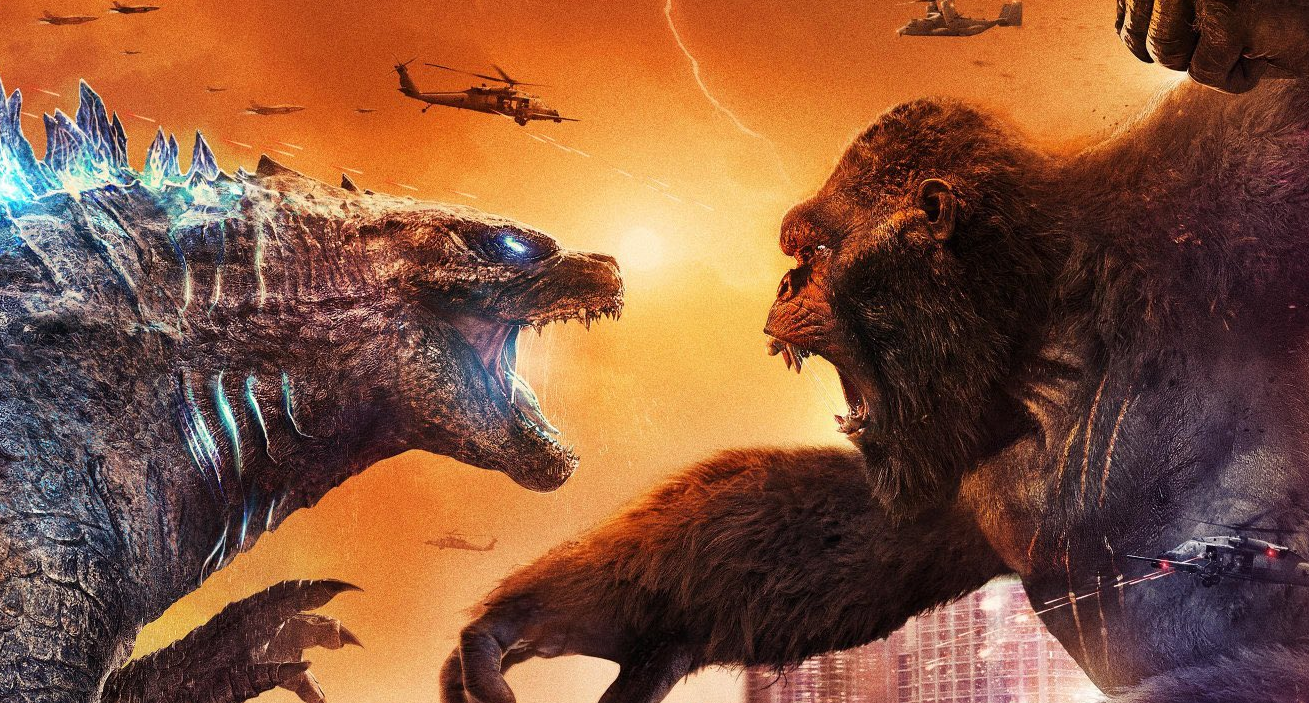Listen, this is a movie about a giant fire-breathing lizard fighting an equally giant monkey. If you’re not on board with that, don’t bother. There’s no dancing around how ridiculous the premise is, but Godzilla vs. Kong sets the bar higher than its predecessors by finally realizing what fans keep turning out for: Gigantic monster clashes that portray Titans both as characters and as massive visual spectacle.
This spiritual successor to the often meme’d 1963 crossover feels like a reverse-engineered blockbuster that is watchable under any context. It is a technically sound, metanarrative-proof action movie that can be watched on any screen size. It’s watchable with Monsterverse knowledge so broad that its directive is conveyed with ease for theatergoers and HBO Max subscribers alike. Anywhere from an IMAX format to a 4K TV with Dolby Atmos all the way down to a 13” laptop screen, the movie proudly displays strong choices of color, scale, and sounds that are awe-inspiring. It deserves to be presented big, loud, and with a crowd.
However you choose to watch it, Godzilla vs. Kong achieves a scale that blows away previous American kaiju movies. The VFX shots of the creatures demonstrate their jaw-dropping scale compared to their human co-stars with loving care for depicting them as characters that can emote to the camera and clear frames that are impressive pieces of digital art on their own.

Director Adam Wingard (The Guest, You’re Next) has a clear love for these monsters and understands the admiration for a favorite kaiju is like following the career of a favorite wrestling star. The battle sequences are the best in the modern takes on the genre, with the monsters’ movement, weight, and fighting styles distinct and uniquely exhilarating. Thanks to an actual source of light either coming from the sun or the towering buildings of Hong Kong, each battle is given clarity and vibrant color to their respective set pieces. The sound design matches the visuals to a ground-shaking scale, absolutely most effective on a Dolby Atmos speaker, but even still sounds great cranked up in stereo.
Of course, you can’t have a giant kaiju movie without at least some human shenanigans to break up the tension and ramp up the stakes, quickly establishing how powerful and stubborn both these Titans are. The lean, focused screenplay by Eric Pearson (Thor: Ragnarok) manages to do this in a couple of ways.
Most importantly, the humans have direct cause and effect in the plot. Kong is duped into leaving Skull Island by humans convinced he can be used to find a source of power in the Hollow Earth. Meanwhile, Godzilla is aggressively cleaning house with a multi-billion dollar company called Apex Cybernetics, and Maddison Russel (Millie Bobbie Brown) is on a quest to find out why. As the two creatures beeline to their destinations, they cross paths and settle old grudge matches with lots of punching, roaring, and destruction.

The film’s split A and B plot never converges, save for the chosen Titans that their threads follow, and their equal need to stop Apex’s instigation of violence. These plotlines click by at a brisk, adventurous pace helped by a reduced runtime, roughly thirty minutes shorter than 2019’s Godzilla: King of the Monsters, but also a much more playful supporting cast with a lot of personality.
Maddison tries to solve the mystery of why Godzilla has gone rogue. Her storyline is joined by Jullien Dennison (Hunt for the Wilderpeople, Deadpool 2) as her skeptical friend Josh, and conspiracy theorist podcaster Bernie (Brian Tyree Henrey). These two supporting actors provide plenty of comedic banter as the two spend most of the film at odds with each other while Maddison solves the plot by discovering Apex’s dangerous secrets. To divulge further would reveal some hints at spoilers, but it’s clear that the answer is nothing good, and will be a fun payoff for fans of classic Toho monsters. The star of Kong’s half of the film is a girl who shares a close bond with King Kong through American Sign Language, giving a platform to a new child actor from an all deaf family, Kaylee Hottle, who absolutely is the heart of the film as she rallies herself behind Kong.
Advertisement
This story doesn’t really want or need to be complicated, and while it feels like it takes its time getting there, the film works to push the monkey and the lizard along their paths by whatever means necessary until they stink eye each other long enough to begin brawling in the final portion of the film. It’s a hard act to balance, and for the average viewer, it seems like there’s a lot to get through before the climactic monster fights, but when you ask a traditional monster movie fan, you’ll find they’re just happy to be here following decades of wooden acting and fifteen-minute montages of matchbox car military tanks. It manages to do this without teetering too far into wall-to-wall insufferable noise like Michael Bay’s Transformer’s films, or the divisive slow pace of Godzilla (2014).
It’s difficult to take the time to analyze these characters when they are clearly not the film’s main draw. Casting inclusions like Alexander Skarsgard, Rebecca Hall, and Eiza Gonzales feel dry and a waste of their talent, but they admittedly come to do the work of selling the science and backstory of this world and little else. Much of the films runtime spends it with these humans, and some viewers might take grievance with this as they did in previous movies. Admittedly, the title fight only pays off at two points throughout the film, with an hour of things happening in the middle. Despite this, GVK improves on its predecessors in this middle hour by using Kong as a core cast member and giving him his own skirmishes and emotional resolutions to deal with on his journey to find a new home.
Conversely, some in the core Godzilla fanbase might be disappointed to find that Kong is presented as the primary Titan, and uncle Goji takes a backseat with regards to equal screentime. The payoff, however, is immeasurable for Godzilla fans by the time the credits roll. They will only feel a sore spot being left with the film underutilizing actor Shun Oguri (Wethering With You) as Ren Serizawa, the son of the late Doctor Ishiro Serizawa (Ken Watanabe) from the past few films. This dangling plot thread makes it evident that, while fans may pick up on this detail, Godzilla vs. Kong’s mission is to be its own movie that needs to keep at its own pace, and easily leaves room for more adaptations of these classic creature features moving forward.
The result is an action movie that is the most accessible in the Legendary Monsterverse yet. There are a couple of beats from the previous film, but the story requires little else from viewers besides buying into the universe by the time the title card hits. Godzilla vs. Kong has a unique ability to exist in a vacuum of itself. It’s a one-off B-movie of yesteryear celebrating two iconic creatures of pop culture. It is exactly the escapism-fueled, gonzo blockbuster that people have been hungry for.
Advertisement
Advertisement
